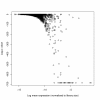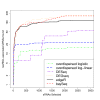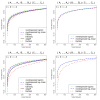baySeq: empirical Bayesian methods for identifying differential expression in sequence count data
- PMID: 20698981
- PMCID: PMC2928208
- DOI: 10.1186/1471-2105-11-422
baySeq: empirical Bayesian methods for identifying differential expression in sequence count data
Abstract
Background: High throughput sequencing has become an important technology for studying expression levels in many types of genomic, and particularly transcriptomic, data. One key way of analysing such data is to look for elements of the data which display particular patterns of differential expression in order to take these forward for further analysis and validation.
Results: We propose a framework for defining patterns of differential expression and develop a novel algorithm, baySeq, which uses an empirical Bayes approach to detect these patterns of differential expression within a set of sequencing samples. The method assumes a negative binomial distribution for the data and derives an empirically determined prior distribution from the entire dataset. We examine the performance of the method on real and simulated data.
Conclusions: Our method performs at least as well, and often better, than existing methods for analyses of pairwise differential expression in both real and simulated data. When we compare methods for the analysis of data from experimental designs involving multiple sample groups, our method again shows substantial gains in performance. We believe that this approach thus represents an important step forward for the analysis of count data from sequencing experiments.
Figures







Similar articles
-
Generalized empirical Bayesian methods for discovery of differential data in high-throughput biology.Bioinformatics. 2016 Jan 15;32(2):195-202. doi: 10.1093/bioinformatics/btv569. Epub 2015 Oct 1. Bioinformatics. 2016. PMID: 26428289
-
Empirical Bayesian analysis of paired high-throughput sequencing data with a beta-binomial distribution.BMC Bioinformatics. 2013 Apr 23;14:135. doi: 10.1186/1471-2105-14-135. BMC Bioinformatics. 2013. PMID: 23617841 Free PMC article.
-
Methods for discovering genomic loci exhibiting complex patterns of differential methylation.BMC Bioinformatics. 2017 Sep 18;18(1):416. doi: 10.1186/s12859-017-1836-0. BMC Bioinformatics. 2017. PMID: 28923005 Free PMC article.
-
Covariate-dependent negative binomial factor analysis of RNA sequencing data.Bioinformatics. 2018 Jul 1;34(13):i61-i69. doi: 10.1093/bioinformatics/bty237. Bioinformatics. 2018. PMID: 29949981 Free PMC article.
-
NPEBseq: nonparametric empirical bayesian-based procedure for differential expression analysis of RNA-seq data.BMC Bioinformatics. 2013 Aug 27;14:262. doi: 10.1186/1471-2105-14-262. BMC Bioinformatics. 2013. PMID: 23981227 Free PMC article.
Cited by
-
Transcriptomic and phylogenetic analysis of a bacterial cell cycle reveals strong associations between gene co-expression and evolution.BMC Genomics. 2013 Jul 5;14:450. doi: 10.1186/1471-2164-14-450. BMC Genomics. 2013. PMID: 23829427 Free PMC article.
-
Long-term quiescent fibroblast cells transit into senescence.PLoS One. 2014 Dec 22;9(12):e115597. doi: 10.1371/journal.pone.0115597. eCollection 2014. PLoS One. 2014. PMID: 25531649 Free PMC article.
-
Comparative assessment of methods for the computational inference of transcript isoform abundance from RNA-seq data.Genome Biol. 2015 Jul 23;16(1):150. doi: 10.1186/s13059-015-0702-5. Genome Biol. 2015. PMID: 26201343 Free PMC article.
-
Buccal Swab Samples from Japanese Brown Cattle Fed with Limonite Reveal Altered Rumen Microbiome.Animals (Basel). 2024 Jul 3;14(13):1968. doi: 10.3390/ani14131968. Animals (Basel). 2024. PMID: 38998081 Free PMC article.
-
Statistical and Bioinformatics Analysis of Data from Bulk and Single-Cell RNA Sequencing Experiments.Methods Mol Biol. 2021;2194:143-175. doi: 10.1007/978-1-0716-0849-4_9. Methods Mol Biol. 2021. PMID: 32926366 Free PMC article. Review.
References
-
- Margulies M, Egholm M, Altman WE, Attiya S, Bader JS, Bemben LA, Berka J, Braverman MS, Chen YJ, Chen Z, Dewell SB, Du L, Fierro JM, Gomes XV, Godwin BC, He W, Helgesen S, Ho CH, Ho CH, Irzyk GP, Jando SC, Alenquer ML, Jarvie TP, Jirage KB, Kim JB, Knight JR, Lanza JR, Leamon JH, Lefkowitz SM, Lei M, Li J, Lohman KL, Lu H, Makhijani VB, McDade KE, McKenna MP, Myers EW, Nickerson E, Nobile JR, Plant R, Puc BP, Ronan MT, Roth GT, Sarkis GJ, Simons JF, Simpson JW, Srinivasan M, Tartaro KR, Tomasz A, Vogt KA, Volkmer GA, Wang SH, Wang Y, Weiner MP, Yu P, Begley RF, Rothberg JM. Genome sequencing in microfabricated high-density picolitre reactors. Nature. 2005;437:376–380. - PMC - PubMed
-
- Mardis ER. The impact of next-generation sequencing technology on genetics. Trends Genet. 2008;24:133–141. - PubMed
Publication types
MeSH terms
Substances
Grants and funding
LinkOut - more resources
Full Text Sources
Other Literature Sources
Molecular Biology Databases

